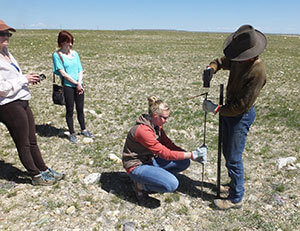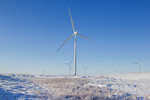UW Research Points to Bug Benefits From Changing Color of Wind Turbines
To test the hypothesis that wind turbine color attracts insects, a group of University of Wyoming researchers -- headed by former UW master’s student Madison Crawford -- sampled insects near experimental wind turbine mimics with nine different colors during summer 2017. The mimics were located on a hill with characteristics similar to sites of nearby wind energy facilities.
“Madison’s study found that insects are attracted to colors with high reflectance generally. White reflects a high proportion of all wavelengths,” says Lusha Tronstad, lead invertebrate zoologist with UW’s Wyoming Natural Diversity Database (WYNDD). “We noticed that the vertical structure also appeared to attract more insects. We compared white traps adjacent to a base mimicking a white wind turbine mimic base compared to locations with only a white trap (the base was absent), suggesting the vertical structure attracts insects as well as the color.”
Tronstad was last author of a paper titled “Insects are attracted to white wind turbine bases: evidence from turbine mimics” that was published recently in Western North American Naturalist, a peer-reviewed journal focusing on biodiversity and conservation of western North America.
According to the study, even just painting the bottom portions of turbine bases a darker shade of color may decrease the abundance of insects and their predators colliding near wind energy facilities. This would provide three benefits: More insects that perform ecological services may be conserved; fewer insect predators, including birds, may be attracted to wind turbines; and fewer insects may soil the surface of blades, leading to a substantial increase in wind turbine energy output.
“I hope a variety of folks read our study because I would like to see this hypothesis tested on a larger scale. To test our idea at a larger scale, we need to work with the wind industry and government officials,” Tronstad says. “Insects do not come to mind when people think of wind turbines, but they should. Insect debris on turbine blades can reduce the power produced by 50 percent when wind speeds exceed 26 mph. If we can reduce insects at wind facilities, more energy may be produced, and fewer birds may be around turbines. That is a potential positive result worth testing.”
Crawford, who received her bachelor’s and master’s degrees in zoology and physiology at UW, was the paper’s lead author. She performed fieldwork, analyzed data and wrote the paper. Crawford, of Newcastle, is now a botanist with the U.S. Forest Service in Dillon, Mont.
 Madison Crawford, who received her bachelor’s and master’s degrees in zoology and physiology from UW (left, holding stake), and Bryan Tronstad, an invertebrate taxonomist with UW’s Wyoming Natural Diversity Database, install structures for Crawford’s study that tested the hypothesis that wind turbine color attracts insects. During the study, which took place in the foothills of the Medicine Bow Mountains during summer 2017, insect abundance was highest next to the white, violet and blue turbine mimics and lowest adjacent to the turbine mimics that were green, orange, yellow, light gray and dark gray. (Image: Lusha Tronstad Photo)
Madison Crawford, who received her bachelor’s and master’s degrees in zoology and physiology from UW (left, holding stake), and Bryan Tronstad, an invertebrate taxonomist with UW’s Wyoming Natural Diversity Database, install structures for Crawford’s study that tested the hypothesis that wind turbine color attracts insects. During the study, which took place in the foothills of the Medicine Bow Mountains during summer 2017, insect abundance was highest next to the white, violet and blue turbine mimics and lowest adjacent to the turbine mimics that were green, orange, yellow, light gray and dark gray. (Image: Lusha Tronstad Photo)
Delina Dority, a UW master’s student from Casper at the time of the study, and Michael Dillon, a UW professor of zoology and physiology, were other authors on the paper. Along with Tronstad, both mentored Crawford during the study. Dority had been investigating insects at wind facilities. Crawford was a UW undergraduate student at the time and wanted to work on her own project, Tronstad says.
Wind power is one of the fastest-growing forms of renewable energy, but interactions between wind turbines and insects are largely unknown beyond observations that the accumulation of dead insects on turbine blades drastically reduces the power the blades produce, the paper says.
Globally, most turbines are painted white so that the structures blend into the sky at ground level, can visibly be seen by aircraft and provide protection from excessive heat, according to the paper.
“Our results suggest that white, the predominant color of wind turbines globally, is one of the most attractive colors to insects,” Crawford wrote in the paper. “We encourage others to investigate whether painting turbine bases a less attractive color -- gray or green -- may drastically reduce the attraction of insects to wind energy facilities.”
During the study, which took place in the foothills of the Medicine Bow Mountains, insect abundance was highest next to the white, violet and blue turbine mimics. Insect abundance was lowest adjacent to the turbine mimics that were green, orange, yellow, light gray and dark gray.
The group sampled insects twice a week from mid-June to the end of July. The research team collected 1,167 specimens representing six orders of insects. True flies, at 58 percent, were most abundant, followed by bees, wasps and ants at 34 percent; beetles at 4 percent; moths at 2 percent; and caddisflies at 1 percent.
“We suggest more studies because this study is the first of its kind. The wind turbine mimics we used were much smaller than commercial wind turbines,” Tronstad explains. “Testing our hypothesis on residential or commercial wind turbines is a next step; however, county, state and federal laws dictate the color of turbines. … We predict painting turbine bases, perhaps only the bottom 10 or 20 yards, may have positive implications for insects and birds near wind facilities.”
The Wyoming NASA Space Grant Consortium and the Wyoming Research Scholars Program at UW funded the research. These programs supported Crawford throughout her project and enabled her to gain excellent skills and conduct valuable research, Tronstad says.
About the Wyoming Natural Diversity Database
WYNDD offers the most complete source of data for species and vegetation communities of management concern in Wyoming. Its mission is threefold: Identify and rank species that are priorities for management in Wyoming; amass existing data and develop new data for species needing management efforts, and for Wyoming vegetation types; and distribute these data upon request, under the philosophy that the best decisions regarding natural resources will be made only when everyone has access to complete and current scientific data.
- Source:
- University of Wyoming
- Author:
- Press Office
- Link:
- www.uwyo.edu/...
- Keywords:
- University of Wyoming, research, studies, wind turbine, colour, insect, biodiversity, rotor blade, light, soil, surface























